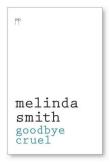AustLit
Latest Issues
AbstractHistoryArchive Description
'Goodbye, Cruel is divided into five sections. An important extended sequence, as the title implies, is an exploration of the often taboo subject of self-destruction. Another communes with the work of Rabi’a Balkhi, the first female poet to write in the Persian language.' (Synopsis)
Publication Details of Only Known VersionEarliest 2 Known Versions of
Works about this Work
-
Quick Thoughts on the Line
2018
single work
essay
— Appears in: Axon : Creative Explorations , May vol. 8 no. 1 2018;'Simon Patton, writing recently in the Sydney Review of Books encourages us to ‘…think of the line as a kind of gesture, a gesture which carries an expressive force’. He contrasts poems in which individual lines ‘achieve sufficient distinctness to make them memorable’ with poems of a more ‘fragmentary quality’ (such as those of Antigone Kefala, whose Fragments he is reviewing). Without valorising one over the other, I would agree that these are two possible approaches to the line. Many others are possible also — from prose poetry’s decision to dispense with the line entirely, to the opening up of gaps or caesurae within lines favoured by many contemporary poets, to formal poetry’s demand that the line contain a certain number of feet, syllables, and / or end rhymes.
'For myself, as a practitioner who writes in both constrained forms and free verse, the line takes on different qualities in different poems. In this brief piece I will consider my approaches to the free verse line, and to lines in poems working against some kind of self-imposed constraint. I will close with a case study of the treatment of the line in translation using an example from Japanese poet Kawaguchi Harumi.' (Introduction)
-
Four New Collections and a Question Mark
2018
single work
review
— Appears in: Meanjin , Autumn vol. 77 no. 1 2018; (p. 194-200) -
[Review Essay] Goodbye, Cruel
2018
single work
essay
— Appears in: StylusLit , March no. 3 2018;'Melinda Smith’s goodbye, cruel is an accomplished collection of poems from an established voice in Australian poetry. This is the fifth collection from the former poetry editor of the Canberra Times. As the title suggests, the prevailing theme of this work is suicide: subject matter that might be mishandled by a maudlin or morbid writer of lesser skill. From Smith’s lines emerges a human pathos, tempered by a humane ethos, as the many voices she creates, mimics, translates, adapts-via-erasure, and adopts-via-cento take on a life (and death) of their own.' (Introduction)
-
Dominique Hecq Reviews Melinda Smith and Caren Florance
2018
single work
essay
— Appears in: Cordite Poetry Review , 1 February no. 84 2018;'Seeking to cast light on Melinda Smith’s Goodbye, Cruelalongside her collaborative work with Caren Florance titled Members Only is like approaching a hive of fully-formed poems. Your step halts in awe of the air abuzz, as your gaze zooms into vivid sharpness. Though thematically and stylistically distinct, these two collection burst with ideas, energies, shapes and reconfigurations of lexicons. They are laden with ripe, yet sharp, shape-changing artefacts.' (Introduction)
-
Dominique Hecq Reviews Melinda Smith and Caren Florance
2018
single work
essay
— Appears in: Cordite Poetry Review , 1 February no. 84 2018;'Seeking to cast light on Melinda Smith’s Goodbye, Cruelalongside her collaborative work with Caren Florance titled Members Only is like approaching a hive of fully-formed poems. Your step halts in awe of the air abuzz, as your gaze zooms into vivid sharpness. Though thematically and stylistically distinct, these two collection burst with ideas, energies, shapes and reconfigurations of lexicons. They are laden with ripe, yet sharp, shape-changing artefacts.' (Introduction)
-
[Review Essay] Goodbye, Cruel
2018
single work
essay
— Appears in: StylusLit , March no. 3 2018;'Melinda Smith’s goodbye, cruel is an accomplished collection of poems from an established voice in Australian poetry. This is the fifth collection from the former poetry editor of the Canberra Times. As the title suggests, the prevailing theme of this work is suicide: subject matter that might be mishandled by a maudlin or morbid writer of lesser skill. From Smith’s lines emerges a human pathos, tempered by a humane ethos, as the many voices she creates, mimics, translates, adapts-via-erasure, and adopts-via-cento take on a life (and death) of their own.' (Introduction)
-
Four New Collections and a Question Mark
2018
single work
review
— Appears in: Meanjin , Autumn vol. 77 no. 1 2018; (p. 194-200) -
Quick Thoughts on the Line
2018
single work
essay
— Appears in: Axon : Creative Explorations , May vol. 8 no. 1 2018;'Simon Patton, writing recently in the Sydney Review of Books encourages us to ‘…think of the line as a kind of gesture, a gesture which carries an expressive force’. He contrasts poems in which individual lines ‘achieve sufficient distinctness to make them memorable’ with poems of a more ‘fragmentary quality’ (such as those of Antigone Kefala, whose Fragments he is reviewing). Without valorising one over the other, I would agree that these are two possible approaches to the line. Many others are possible also — from prose poetry’s decision to dispense with the line entirely, to the opening up of gaps or caesurae within lines favoured by many contemporary poets, to formal poetry’s demand that the line contain a certain number of feet, syllables, and / or end rhymes.
'For myself, as a practitioner who writes in both constrained forms and free verse, the line takes on different qualities in different poems. In this brief piece I will consider my approaches to the free verse line, and to lines in poems working against some kind of self-imposed constraint. I will close with a case study of the treatment of the line in translation using an example from Japanese poet Kawaguchi Harumi.' (Introduction)




